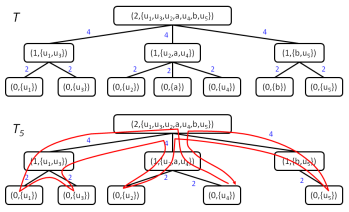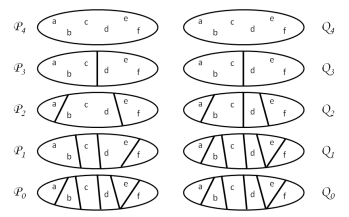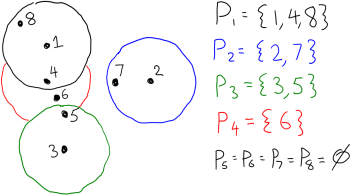The algorithm for probabilistically embedding metric spaces into trees has numerous theoretical applications. It is a key tool in the design of many approximation algorithms and online algorithms. Today we will illustrate the usefulness of these trees in designing an algorithm for the online Steiner tree problem.
1. Online Steiner Tree
Let be a graph and let
be lengths on the edges. Let
be the shortest path metric on
.
For any , a Steiner tree is a subtree of
that spans (i.e., contains) all vertices in
, but does not necessarily span all of
. The vertices in
are called “terminals”. Equivalently, we can define a Steiner tree to be an acyclic, connected subgraph of
that spans all of
. Computing a minimum-length Steiner tree is NP-hard.
Today we consider the problem of constructing a Steiner tree in an online setting. There is a sequence of time steps. In each time step
, we are given a vertex
. Our algorithm must then choose a connected subgraph
of
which spans
(and possibly other vertices). The objective is to minimize the total length
. Since we only care about the cost of the union of the
‘s, we may assume without loss of generality that
. There is no restriction on computation time of the algorithm.
Remark. The ‘s are not actually Steiner trees because we did not insist that they are acyclic. If trees are desired, one could remove cycles from each
arbitrarily. This is equivalent to the problem that we stated above.
If we knew the terminal set in advance then the problem is trivial. The algorithm could compute in exponential time the minimum-length Steiner tree
spanning
, then set
in every time step. Unfortunately the algorithm does not know
in advance. Instead, our goal will be for the algorithm to behave almost as well as if it did know
. Formally, define competitive ratio of the algorithm to be the ratio
We want our algorithm to have small competitive ratio.
Theorem 1 There is a randomized, polynomial time algorithm with expected competitive ratio
.
I think this is optimal but I could not find a definitive reference. For very similar problems, Alon & Azar prove a lower bound and Imase & Waxman prove a
lower bound.
1.1. The Algorithm
The main idea is to use algorithm of the last lecture to approximate the metric by a tree
with edge lengths
. Let
be the corresponding distance function on
. Recall that the leaves of
are identified with the vertices in
. The algorithm will then build a sequence of Steiner trees
that are subtrees of
, where each
spans
. This is trivial: since
is itself a tree, there is really only one reasonable choice for what
should be. We set
to be the unique minimal subtree of
that spans
.
Remark. This step of the algorithm illustrates the usefulness of probabilistically approximating the metric by a tree. Many problems can be solved either trivially or by very simple algorithms, when the underlying graph is a tree.
Clearly . We would like to understand how the length of our final Steiner tree
compares to the optimal Steiner tree
.
Unfortunately the tree itself isn’t a solution to our problem. Recall that
is not a subtree of
: the construction of
required adding extra vertices and edges. So
is not a subtree of
either. To obtain our actual solution, we will see below how to use the trees
to guide our construction of the desired subgraphs
of
.
Proof: (of Claim 2). Let be an ordering of the terminals given by a depth-first traversal of
. Equivalently, let
denote the graph obtained from
by replacing every edge with two parallel copies. Perform an Euler tour of
, and let
be the order in which the terminals are visited.

The Euler tour traverses every edge of exactly once, so
is exactly half the length of the Euler tour. Thus
Now consider performing a walk through , visiting the terminals in the order given by
. Since this walk visits every leaf of
, it is a traversal of the tree, and hence it crosses every edge at least once. (In fact, it is an Eulerian walk, so it crosses every edge at least twice.)

Remark. The analysis in (3) illustrates why our random tree is so useful. The quantity that we’re trying to analyze (namely
) is bounded by a linear function of some distances in the tree (namely
). Because we can bound
by
, and because of linearity of expectation, we obtain a bound on
involving distances in
.
Now let us explain how the algorithm actually solves the online Steiner tree problem. It will maintain a sequence of subgraphs of
such that each
spans
. Initially
. Then at every subsequent time step
, we do the following.
- Let
be the closest vertex to
amongst
, using distances in
. In other words,
.
- Let
be a shortest path in
from
to
.
- Let
.
The trees described above can also be viewed in this iterative fashion. Initially
. Then at every subsequent time step
, we do the following.
- Let
be the unique path in
from
to the closest vertex in
.
- Let
.

The following important claim relates and
.
Proof: Let be the closest vertex in
to
, so
is a
–
path. The vertex
would only be added to
if some leaf
beneath
belongs to
. By the choice of weights in
, the weight of the
–
path is no longer than the weight of the
–
path. Thus
for all
. Consequently
as required.
Consequently,
since is the union of the
paths and
is the disjoint union of the
paths. So
by Claim 2. This proves that the expected competitive ratio is .




